| Army of Revolution | |
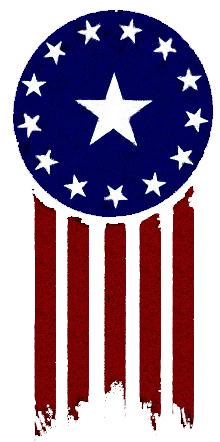
| |
| Political Information | |
| Class: | Raider |
| Leader Title: | Colonel |
| Leader: | Martin Kruger |
| Motto: | Making America American again |
| Societal Information | |
| Location: | Detroit Wasteland |
| Historical Information | |
| Policy Information | |
| Goals: | Conquest |
| Allies: | The Foundry |
| Enemies: | Black Skull Company |
Key The Army of Revolution is a human supremacist organisation seeking to take control of the Detroit Wasteland through force and unify it under their rule. A militaristic and expansionist organisation, the Army has deliberately attempted to emulate the pre-war US military to the point of appropriating its symbology and terminology.
History
Formation
Officially, the Army of Revolution claims to be descended from a pre-war organisation formed during the 1970s, making it over three hundred years old. These claims have never been verified, and no evidence has been found to support them. The modern incarnation of the army was formed in 2245, born out of a collection of mercenaries and former soldiers with obvious military experience who had chosen to unify under a single banner to their mutual benefit.
Initially offering themselves purely as a mercenary outfit, the Army of Revolution sought to monopolise the market in the Detroit Wasteland. This was achieved through strong-arming other outfits or independent operators into either joining them or leaving the trade altogether. Those that refused the Army’s offers quickly found themselves under attack by them instead. This predatory behaviour allowed the Army of Revolution to not only quickly grow, but to also achieve a dominant position in the region. It also had the side effect of spurring on the formation of the Black Skull Company in 2249, which set itself up in opposition. Initially, the Army of Revolution were not concerned about this, seeing the Black Skulls as being a minor nuisance that they would deal with in time. This oversight would come to cost them in the long run.
Having established themselves, the Army of Revolution began to aggressively target raider bands on the fringes of the wasteland. This was done in order to expand their numbers, rather then out of any desire to eliminate them as a threat to various communities. Those raiders they targeted were given a choice of being conscripted into the army or killed, with many choosing the former option. This move allowed the army’s numbers to swell, even if it was with low-end cannon fodder troops.
Change of Tactics
With a considerable force at their disposal, the Army of Revolution began to change their approach towards mercenary work. While they did continue to take paid contracts, they also started a program of intimidating settlements or other groups into paying the Army for protection. Those that refused would find themselves under attack from the Army, or alternatively stripped of their defences and left to whatever other threats awaited them.
As these operations proved to be successful, the Army of Revolution began to move away from mercenary work and towards becoming a full-blown raider army. They began staging attacks in force against settlements and traders, simply taking whatever they wanted without the pretence of doing such under anyone’s employ. On occasion they would even seize control of smaller settlements or outposts, stripping them of anything of any worth. Those that they took captive would be conscripted into their ranks, allowing the army to make up the losses it suffered in its raids. The Army would often specifically target explorers and scavengers, looking for those who could lead them to caches of pre-war technology and equipment.
These efforts allowed the army to grow considerably, building a sizeable fighting force, even if much of it was of dubious quality. However, they would also have unforeseen consequences that would cost the Army in the long term.
Retaliation
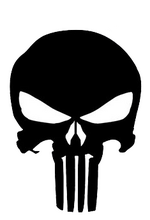
Black Skull Company
Beginning in 2264, the Black Skull Company began a campaign that deliberately targeted the Army of Revolution in an effort to curb their activities. Not only did they offer their services towards those communities that the Army had attacked in past, but the mercenary organisation began going after the Army’s operations and territories.
At first, the Army of Revolution was unaware that they were being directly put under the spotlight, and simply assumed that they were facing retaliatory attacks for their own raids. A part of this came about due to the Army’s size; having grown so fast and occupied a fair swathe of territory, the lines of communication became somewhat tangled, making it hard to realise that these attacks were coming from a single, well-coordinated group.
As losses began to mount, the Army of Revolution attempted their own counteroffensive by stepping up their operations. Instead of eliminating the Black Skull Company as they had hoped, this plan instead wound up exposing their forces even more and increasing losses. Adding to their irritation, the Army’s leadership found that even the communities they targeted were putting up more of a fight, apparently buoyed by the idea that somebody was supporting them.
Rather than continue to exacerbate a bad situation, the Army’s leadership made the decision to scale back operations within the Detroit Wasteland and consolidate their remaining forces. Pulling back, they instead chose to restrict themselves to operating in the rural areas north of the city, rather than risk further escalation. As expected, the Black Skull Company responded in kind, apparently unwilling to overextend themselves.
The Long Winter
The 2270s were not kind to the Army of Revolution. All but expelled from Detroit proper, they found themselves instead going after scraps and smaller communities that had far less to offer them. Eastern Michigan proved to be slim pickings, which in turn saw numbers fall as members of the army deserted for more lucrative climes. A series of harsh moves by the leadership staunched the flow of losses, but it was clear that more needed to be done.
In order to aid in their rebuilding, the Army of Revolution returned again to mercenary work. Small units were hired out, often stripped of anything that would identify them as being a part of the Army proper. These operations helped to bring in caps, supplies and even raw recruits, the latter of which were signed up under the belief that they would be working for a smaller outfit and not realising exactly what it was they had gotten into.
By 2275, the Army of Revolution had begun to turn itself around. Numbers were again increasing, and the organisation had somewhat rebuilt its depleted stocks of weaponry and equipment. Tentative feelers showed that the situation in the Detroit Wasteland had remained largely unchanged, while their enemies in the Black Skull Company seemed to have lost interest in them and were instead focusing on their own mercenary operations.
However, it was two unconnected events that would prove to be the most beneficial to the Army of Revolution. The first was the savage defeat dealt to the Black Skulls during the battle of Zug Island, which cost them their leader and a number of their most skilled soldiers. It also meant that the largest and best organised force opposed to them had suddenly been substantially weakened without their needing to be involved at all.
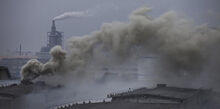
The Foundry
The second was the rise of the Foundry in the Flint River region. While beyond the territories that the Army of Revolution operated in, the Foundry offered them a source of weapons and equipment that could be used to rebuild their forces. Seeing an opportunity, the Army’s leadership struck a trade deal with the Forgemaster, swapping weapons for food and other supplies. Soon Foundry-made rifles were finding their way into the hands of Revolutionary soldiers.
The Revolutionary War
With an expanded arsenal, the Army began a new recruitment drive, once again swelling its ranks. Confident in their growing army, and seeing that their enemies remained weak and unfocused, the Army’s leadership began work on an ambitious plan, one that aimed to bring the Detroit Wasteland under their control. While audacious in its scope, they felt that their numbers were enough to make their goals viable.
Launched in Spring 2284, the first stage of the Revolutionary War saw the Army drive in from the northeast in mass numbers. Sweeping through the largely abandoned outer suburbs, they encountered only scattered resistance from raiders and scavengers. Many groups surrendered after realising just what sort of numbers they were up against, with their members quickly conscripted into the army’s ranks.
With their numbers actually growing through such efforts, the Army then proceeded with their second stage and launched attacks on several of the communities in the northern portions of the Wasteland. Isolated and unable to coordinate their defences, these communities fell easily to their offensive. In each case, the Army occupied them and began stripping them of anything of worth. However, they also left existing trade networks and businesses intact in order to ensure their functionality after the war.
By this point, news of what was happening had spread to a number of other communities who were taking their own measures to prepare for the inevitable onslaught. The Army of Revolution had expected them to do such, and initially were not concerned. Instead, they stuck to their plan, which called for them to bypass downtown and instead swing to the south-east to attack a number of the communities present. Fully aware that this would put Black Skull Company in the line of fire, the army’s leadership remained confident that they would be able to overcome the mercenary outfit through the sheer weight of numbers that they fielded.
Instead of taking them on head-on, the Black Skulls chose to break up into platoon-sized units and pull the Army of Revolution into a protracted guerrilla war. Facing attacks on their supply lines and being pulled into the downtown district, the Army found it ever increasingly difficult to maintain their offensive. Morale plummeted as their forces faced constant, unpredictable attacks while insurgencies broke out across their occupied territories.
As efforts to contain the damage failed, the Army of Revolution was confronted with a new threat. Desertions became commonplace, especially among the conscript troops that had formed the bulk of their offensive. With their front crumbling, the Army also found themselves under opportunistic attacks from raiders and Super Mutants who saw an opportunity to pick at the carcass of their offensive.
Realising that they were now in severe danger of catastrophic losses, the Army’s leadership ordered a coordinated withdrawal back to their occupied settlements in the norther wastes. Instead, what occurred was a chaotic rout as their forces lost cohesion and broke, with many simply melting into the ruins rather than trying to make it back to friendly lines. By the time the smoke had cleared, the Army of Revolution had lost most of what it had captured, with very little to show for their massive losses. Of the five settlements they had targeted, only two, Scrap Iron City and Baggie High had actually been captured and held.
Aftermath
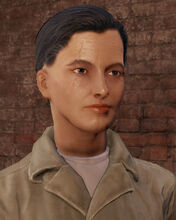
Olivia Milton
With the war an unmitigated disaster, Martin Kruger, the military commander of the Army's campaign, realised that the blame for much of what had happened would fall squarely on him. Seeking to shore up his position, he staged a coup, deposing the army's leader, Olivia Milton. Knowing that she would still have her supporters, he opted to keep her alive, but also out of the line of power.
Having reaffirmed their position, the Army’s leadership engaged in a bloody purge aimed ad eliminating those that were seen as responsible for the debacle. The shattered morale of their army was ‘reinforced’ through public floggings and executions, designed to remind their soldiers of the consequences of their failures. However, nothing could disguise the scale of the losses they had suffered, forcing the army to once more engage in recruitment drives, trying to pluck warm bodies from its newly occupied territories.
At the same time, it has undergone something of an internal reorganisation as its leadership seeks to address the problems that lead to its crippling defeat. Key among those has been a newfound emphasis on intelligence gathering in order to get a better understanding of their enemies and their something that was somewhat lacking during the Revolutionary War. Likewise, efforts have been made to streamline the chain of command and untangle the mess that so hampered communication during the conflict.
In late 2286, the Army of Revolution approached the Foundry with eyes to expanding their relationship. Moving beyond simply trade partners, the Army sought a partner to help them build a pro-human state in Michigan, hoping that the Foundry’s success in the Flint River War would encourage them towards aid. The talks did not yield any results, but the Army’s leadership remained hopeful.
Death to Mercenaries
By January 2287, Kruger felt that the Army of Revolution had rebuilt its strength enough to allow them to begin making more overt moves towards their goals. Despite the ongoing problems with Scrap Iron City, their situation had stabilised while many of their internal issues had been quietly dealt with. Several of Milton’s more vocal remaining supporters had stepped down, while some others had been won over through the results of Kruger’s intelligence gathering campaigns. Internally confident, Kruger began to move forwards with the next stage of his plans.
A key part of his plans for the future was a levelling of the playing field through the elimination of elements that could potentially interfere with any future conflicts. Primary among his concerns were the city’s considerable mercenary population. These independent groups and even individual had played a significant part in the army’s defeat in during the Revolutionary War and, as such he felt that their elimination or at least a reduction in their numbers would be a significant advantage to the Revolutionaries in any future actions.
Where possible, Kruger’s agents tried to simply buy off mercenary groups, or suborn them through third parties. However, there were also enough groups and individuals that they felt they would be unable to buy the loyalty of that would require the army to act more directly. Of course, Black Skull Company remained their chief threat, however the Army was wary about openly moving against the unit given their shared pasts. Their chief concern was that any such overt move might trigger a greater retaliation that could undermine all that Kruger had done so far.
One particular mercenary unit fell in the army’s sights. This group, which did not operate out of Park Lane like many others, had cost the Army of Revolution a golden opportunity to bolster their forces. They had apparently deliberately targeted a scouting team that were in the process of retrieving an intact Power Armour suit, a weapon that could have been a considerable asset to the Army’s forces. As such, the targeting of this group was aimed not only at eliminating them as a threat, but also with an eye to potentially retrieving the suit.
Unfortunately, this attack was also a failure, and only served to tip off the mercenary band to their intent. Wary of further aggrivating the situation while other elements were in play, Kruger ordered his men to back off for the moment.
Outbreak and Backlash
The start of 2287 bought an unexpected opportunity to Kruger, one that would ultimately have long-term consequences. A viral outbreak within the Foundry created a need for medicines to treat it. Fortunately, the Army of Revolution had a means to fulfil that need through the chem labs in Baggie High. However, Kruger felt that not only could he help his ally, but he could also strengthen his position and gain some degree of leverage over them.
Acting through messengers and Olivia Milton, his ambassador to the Foundry, Kruger offered the Forgemaster medicines they needed, but at an exorbitantly inflated price. He demanded more guns and ammunition from them while threating to withhold the medicines from them, in essence blackmailing the Forgmaster. While Milton protested, Kruger persisted, and eventually the Forgemaster, seemingly backed into a corner, relented.
For the next month, the Army maintained this one-sided deal. New weapons flowed into its arsenal, quickly offsetting the lost trade caused by the disruptions in Scrap Iron City. While the Foundry complained, they had little option but to go along with the bargain for the moment. In the Detroit Wasteland, the crews at Baggie High worked around the clock to fulfil demand, further compromising the settlement’s already unsafe conditions.
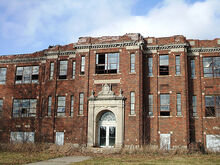
Baggie High
The seemingly inevitable occurred in February of 2287 when a fire broke out in one of Baggie High’s chem labs. Fueled by the abundance of material at hand and the poor conditions within the settlement, the fire spread quickly and soon engulfed the entire settlement. Efforts to stop its spread came to nothing, and overnight the settlement burned to the ground. Its population fled, with many of them effectively escaping the Army of Revolution’s grasp to Arsetown. Meanwhile, the garrison relocated to Scrap Iron City as a stopgap measure while they figured out what to do next.
The loss of Baggie High left the Army of Revolution’s leadership reeling. Abruptly, one of their conquered settlements, as well as their sole leverage over the Foundry had literally gone up in smoke. On top of that, they had overnight lost half their limited gains in the Revolutionary War without a shot being fired. The subsequent uprising in Scrap Iron City threatened to completely eliminate those gains, effectively risking pushing the Revolutionaries out of the Detroit Wasteland entirely. News of the two events spread quickly through the army’s ranks, creating an air of uncertainty and concern, and serving to sap morale.
Adding to their problems was that the Foundry somehow discovered what had happened (Despite Kruger’s efforts to keep a lid on matters) and quickly reversed their previous one-sided dealings. The Army of Revolution had suddenly found its biggest source of new weapons to be far less willing to deal with them, further jeopardising their situation.
Seeing a potential weakness, Kruger put several plans into motion to shore up the Army’s position and try to regain control of the situation. His first move was to distribute the troops who had retreated from Baggie High to a series of outposts. This move was aimed at relieving the pressure on the Scrap Iron City garrison by giving them back their space while also hopefully giving them more room to move in dealing with the insurgents while not having to trip over their comrades. It also established a buffer space between Scrap Iron City and Chryslus Castle to deter the latter from taking advantage of their sudden weakness.
Behind the scenes, Kruger began pouring over the intelligence that his agents had collected over the past months, looking for opportunities. He had always planned to move against the other settlements when the time was right, but fate had now forced his hand. Using the network of spies, agents and go-betweens he had at hand, he launched several plans into motion that were aimed at destabilizing their opponents and creating an opportunity for the army to expand its holdings.
New Alliances
The combination of the loss of Baggie High, the uprising in Scrap Iron City and the reversal of fortune in dealing with the Foundry had left Kruger in a precarious position. He had come to power by claiming incompetence on the part of the army’s past leader, but now there were questions hanging over his head as to his own abilities and capacity to lead. While maintaining an outwardly cool demeanour, he began speeding up plans that he had already put into motion aimed at strengthening the army’s position and, by extension, his own.
Fortunately for him, fate seemed to be on his side for the moment. While the Army of Revolution had no hand in the Scrap Dogs attack on Park Lane, the battle and its aftermath served his purposes well. It had left the city’s most powerful raider gang, one that had in past been openly hostile towards the army, considerably weakened. At the same time, it had sapped Park Lane’s defenses, further weakening the city after the loss of its leadership.
Added to this was an event that nobody could have predicted and yet played so well to Kruger’s plans. The Super Mutant attacks on Park Lane and Grand Central served to focus the attention of those two communities on Zug Island, and away from the more mundane threat that the Army of Revolution presented. Furthermore, the two communities had hired the Black Skull Company, long considered to be the Army’s greatest threat and the group most responsible for their defeat, to contain and control the mutant threat, effectively taking them off the board for the moment.
With his enemies now weak and distracted, Kruger looked to recruit potential allies for the next stage of his plan. The Foundry was proving to be unwilling to involve themselves directly with the Detroit Wasteland, and intelligence he had received indicated that a pro-Army member of the city’s leadership had recently been executed. With that in mind, he dismissed the idea of using the Foundry’s forces to achieve his aims, but that did not rule out using the weapons that they had provided the army with.
Using intelligence provided by his agents, Kruger assessed a number of the city’s raider groups for possible allies. Despite their strengths, several of the raider gangs were considered as allies but ultimately disregarded. The Wrecking Crew, while powerful, was considered to be too unpredictable due to its unhinged leader, David David David David David David Plop. Their leader’s habit of violently lashing out at things at random did not make him a desirable ally, especially given the losses he had inflicted on the Army of Revolution during the Revolutionary War. Relying on him was considered to be a poor choice, while arming him would be decidedly counterproductive.
Similarly, the trio of gangs that controlled the city’s slaving trade, the War Bears, the Gentlemen and the Shackles, were considered to be not useful as allies. With the three of them engaged in a rapidly escalating war, they would not be able to focus their efforts on the army’s targets and would instead be more interested in wiping out each other. The idea of aiding one of the gangs against the other two was ruled out, as it was felt that doing such would just draw the Army into a dragged-out conflict with no clear exit and sap their strength rather than augmenting it.
Two of the remaining gangs stood out, albeit for different reasons. The losses suffered by the Scrap Dogs had left them in a suddenly precarious position, one that they had a need to bolster. Knowing their interest in machinery and technology, Kruger had agents approach them with an offer of scrap and components taken from Scrap Iron City, along with caps, chems left over from Baggie High and a supply of Foundry-made weapons. Furthermore, he promised them that if they aided the army, they would receive a split of the loot. While Roughcut was dubious about an alliance, the losses they had suffered and tewere enough to make him agree.
A second raider gang also presented themselves as a viable option, one that the Army had used in past. Kruger’s agents approached Mrs Mothrapickles, the leader of Cake or Death, and offered an expanded version of the same deal they had made before the Revolutionary War. This time around, they asked Mrs. Mothrapickles to use her force to distract Chryslus Castle and tie up their defenders. In return, the offered her a payment of Foundry rifles, caps and a considerable supply of Fancy Lads Snack Cakes. Mrs. Mothrapickles readily agreed, essentially putting her gang at the Army’s disposal.
Finally, despite its previous entanglements with mercenaries, the Army of Revolution built up a cadre of hired guns to help bolster their numbers. Like the gangs, these groups and individuals were paid off in caps and weapons, with a promise of more to come. This hiring spree drained the Army’s financial reserves, leaving it in a precarious position, but with the potential to massively expand its reach.
The Battle of Park Lane
On the first of June, 2287, Martin Kruger launched he first stage of what he called operation JUST RETURN. On his orders, Army of Revolution units from both Scrap Iron City and other locations, including those relayed from the Mental Hospital, began moving southwards en masse. These groups moved through the Scrap Dogs’ territories, left unharmed due to the alliance with the raider band. Groups of mercenaries rendezvoused with them at pre-set locations as the army forces began quietly taking up positions around Park Lane.
These forces were under instructions to lay low and avoid conflict with the Park Lane Safety Patrol, or even opportunistic attacks on traders and merchant caravans. Instead, they were to lay low until they were given further instructions. Members of the Scrap Dogs went about their usual business, giving no indication that there was anything unusual going on, instead presenting an air of normalcy (In as far as such can be applied to raiders).
At dawn on the sixth of June, the couriers delivered ‘go’ orders to the Army’s forces, as well as their allies. The first wave of scouts (many of whom were disguised as raiders) went into motion, quickly clearing paths towards the city proper while noting the locations of Safety Patrol forces. Encountering no unusual resistance or other significant obstacles, they reported back to their staging bases with their intelligence.
After a quick exchange of couriers, the Army’s forces gave the go-ahead for stage two of the operation. Army of Revolution soldiers, supported by no small amount of mercenaries and Scrap Dogs raiders advanced across the wastelands towards the city. Several safety patrol groups were ambushed and quickly eliminated en-route, although concealing the entirety of their advance was going to be impossible given the scale of it. However, they were not expecting just how large a force there would be.
The Army hit Park Lane’s defences with a larger force then they had ever bought to bear against it during the Revolutionary War. Immediately they came under fire from both static defences such as turrets and the defenders on the wall, which included both members of the PLSP and their remaining mercenary allies. In addition, the defenders were supported by fire from the upper levels of Park Lane’s buildings. This was expected, and the attacking forces were ready for such a defence based on their prior attacks.
In response, the attackers bought up heavy weapons, including missile launchers, to batter the defenders and their defences. These were supplemented by a pair of ‘heavy’ units, being the Scrap Dogs’ power armour suit, and their modified Assaultron. With the PLSP being short on heavy weapons themselves, the attackers were able to force them back and then open a breach in the northern wall of the town. Surging in, they pushed into the main square of the town as the defenders were trying to regroup.
Hastily thrown up barricades went some way towards slowing the attackers, but momentum was on their side. The Army of Revolution’s forces were buoyed by their success, whereas the Safety Patrol’s forces and their allies were drained from the constant fighting that they had been caught up in for the las couple of months. Safety Patrol officers began withdrawing civilians towards the south end of town as they did their best to hold back the tide. Realising the full depth of his situation, Chief Ernesto Salsa swallowed his pride and sent runners to Grand Central and Chryslus Castle, requesting assistance.
Pausing only briefly, the Army of Revolution continued their advance, spreading out not only through the streets but the surrounding buildings. The latter proved to be problematic as the Safety Patrol had dug in and done their best to prevent access to any attackers. The Revolutionaries’ advance quickly slowed to house to house and even room to room fighting, but proved to be inexorable as they slowly gained ground
After three days of fighting, the Park Lane itself had fallen, while much of the Edmund was now in the Revolutionaries’ hands. Realising that he was fighting a losing battle with his forces confined to the smaller buildings at the southern end of the town, Salsa admitted that the town was probably lost. By this point, only a token force of GCPD officers had shown up, admitting that their city was more worried about the Super Mutants. The runners sent to Chryslus had never made it, being picked off by Raiders along the way. Even then, the castle’s defenders were caught up in a wave of raids by Cake or Death (who had been paid to do so by the Revolutionaries)
As Salsa’s remaining officers bought them some time, the GCPD officers collected up as many civilians as they could. Leaving the city, they headed south towards Grand Central, using the freeway to avoid the worst of the surrounding regions. With the remaining civilians either sheltering in the southern end of town or joining in the fighting, Salsa did his best to buy time and slow what was now seen as being an inevitable victory. On the twelfth of June, the last remaining Safety Patrol officers were killed making a stand. The fighting was declared over, with the Army of Revolution having claimed Park Lane.
Threat Reduction
While the Army of Revolution had secured Park Lane, the threat of Black Skull Company still remained. The mercenary unit were presently engaged with the Super Mutants of Zug Island, but that situation would only last so long. Kruger knew that sooner or later they would extricate themselves from that campaign, and when they did, they would have the Army of Revolution firmly in their sights. Furthermore, he suspected that Grand Central and even Chryslus Castle would be willing to pay the mercenaries in order to remove the Revolution from Park Lane.
Reports reached the army that just such events were transpiring, with the Black Skull Company moving to take back Park Lane. Warned in advance, the garrison not only dug in and took up positions, but they also coerced the Scrap Dogs into providing support for their defence. Furthermore, one of their mercenary groups, Rawson's Razors, proposed a counterattack plan to remove the Black Skull Company as a threat.
As expected, Black Skull Company met stiff resistance when they tried to retake Park Lane. Learning from their successful invasion, the Black Skull Company used many of the tricks that the Safety Patrol had used against them. The troops on the walls (having been repaired since the successful conquest of the town) were supported by well dug-in soldiers on the upper floors of the community’s buildings, allowing them to pin down the Black Skull troops as they advanced. Unable to make any substantial progress, the company fell back to their headquarters.
This was a part of Rawson and the Army’s plan. As soon as Park Lane was secure, the Revolutionaries and the Razors set of in pursuit of their enemies. Furthermore, as a contingency, they had tapped Mrs Mothrapickles and the Cake or Death raider gang to support their actions by closing off potential escape routes. The destruction of the Black Skull Company now seemed to be just a matter of time.
As a prelude to the first stage of their assault, an infiltrator (the same one who had killed the Park Lane city council) planted explosives at several key points around the Black Skull Company’s headquarters. These were detonated, weakening their defences and leaving the mercenaries off-balance and on the back foot as the attack began. The first shots were fired as the Black Skull Company were still trying to figure out what was going on.
Moving quickly so they would be able to maintain their momentum, the Army of Revolution forces managed to storm the castle and push the Black Skulls back. As the battle turned into an ugly, close-range brawl, the Skulls were left with no option but to withdraw. Using their remaining heavy troops and munitions they were able to stage a breakout and headed south-west towards Grand Central. However, this move was anticipated, and the Army of Revolution had Cake or Death on standby to intercept the fleeing mercenaries.
Except that Cake or Death never materialised, having broken contact with their supposed allies. The Black Skull Company were consequently able to escape, and make it to Grand Central, much to Kruger's frustration.
The Jaws of Victory
Despite Black Skull Company making its escape, Kruger was buoyed by the news of what had happened during the battle. The Army of Revolution had held Park Lane, and in doing such it had managed to severely weaken one of its greatest enemies. Everything was unfolding as he had planned it, and the Army of Revolution were poised to become the undisputed power in the Detroit Wastelands. With Grand Central apparently cowed and Chryslus Castle remaining aloof, there was little left to oppose him.
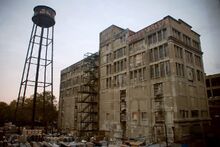
Scrap Iron City
On the 14th of June, Gerald Bunsen, the commander of the garrison forces in Scrap Iron City, was killed in a horrific accident involving a smelter. Given the situation within the city, this event was immediately treated with suspicion, and that this was the latest move by the city’s resistance movement. Bunsen’s second, Isabella Webb, quickly took command of the city; a brief exchange of runners made it clear that her first task would be to locate Bunsen’s killer and ensure that they were bought to very public justice.
Instead, Webb publicly declared her (and Scrap Iron City’s) allegiance to former colonel Olivia Milton, stating that Kruger’s coup had been an illegal action aimed at covering up his own incompetence and failings. As she did, several officers within her command were summarily arrested by soldiers loyal to her in order to ensure that there would be no direct opposition to her move. Strangely enough, the Scrap Iron City resistance proved to be suddenly silent during these events, as if they were entirely on Webb’s side.
Realising what had happened, Kruger ordered troops to march on Scrap Iron City to take it back from the rebels. Instead, confusion reigned among the army’s ranks as to what was actually going on and who was calling the shots. A number of officers openly declared for Milton (or Webb) and instead moved to either support Scrap Iron City or, at the very least, shut down their loyalist comrades. This confusion went as far as the garrison in Park Lane, a number of which came out in support of Milton or Webb.
As a confused tangle of messages reached Kruger, he desperately tried to take control of the situation and reign in what was a quickly escalating uprising. Orders went out to detain and suppress any pro-Milton commanders and soldiers by ‘any means necessary’. This only served to cause further confusion as many asked why they were turning on their fellow soldiers, not having a full grasp of the political manoeuvrings at the top of the army’s ranks. Skirmishes and firefights broke out between groups as matters became increasingly confused, with many not entirely sure who was supporting who.
Despite their alliance, the Scrap Dogs refused to act, claiming that this was a purely internal matter and thus not in their deal (Which had been primarily about taking Park Lane and allowing the Army secure supply routes). Conversely, Cake or Death remained dark, not answering to any attempts at communication from the Army of Revolution.
With the pro-Kruger loyalist faction confused but still representing the majority of the Army’s personnel (Many of whom had only been recruited or inducted after the Revolutionary war), the pro-Milton rebel faction chose to act. A quick exchange of messages saw the bulk of the rebel faction decamp and mobilise, heading in one of two directions. Those within the city, especially those in Park Lane, headed towards Scrap Iron City, which was now firmly in rebel hands. Conversely, those outside it, such as those at the Army’s headquarters or its posts along the way, instead left the city and headed towards the Foundry, where Olivia Milton had been exiled.
The Army of Revolution had effectively lost control of Scrap Iron City overnight, and had suddenly suffered a massive loss of manpower. Having previously been on the verge of victory, now it was perilously close to a civil war.
Degeneration
While the Army of Revolution had not yet erupted into open civil war, the situation within its ranks remained one of uncertainty and confusion. Few within the rank and file of its membership knew exactly what was going on with many instead simply following the orders of their immediate superior in the hope that they had a better idea of the overall situation. Skirmishes broke out between the forces in Scrap Iron City and those loyal to Kruger, but both sides seemed to be careful not to let things escalate.
Besides the ongoing situation with the rebels, Colonel Kruger had other things to worry about. The Foundry’s offering shelter to the rebel faction made it clear that their alliance with the Army of Revolution was over, and he suspected that one of the reasons why they had taken this course of action was ambassador Olivia Milton. By appearing sympathetic to the Foundry and opposing Kruger’s price hikes for medicine, she had likely won the favour of the Forgemaster, which in turn had influenced their decision. This meant that now not only was the Army cut off from its source of new weapons, but it now had a new potential enemy.
The situation got worse when in mid-August the Army of Revolution suffered a number of attacks across its holdings in the Detroit Wasteland. These strikes were small scale and surgical, with the attackers hitting their targets and then fading back into the ruins. Kruger and his analysts reasoned that it was the same mercenary group they had tangled with before who either had been hired to attack them or simply were out for revenge. He ordered another strike on their headquarters (an old Red Rocket station) only to receive word that it had been abandoned, with the mercenaries apparently going to ground.
With no sign as to where the attacks were coming from, the Army of Revolution was stuck in a largely reactionary position. More strikes targeted supply columns and outposts, with the attackers taking out their targets and then retreating before reinforcements arrived. On Kruger’s orders, a number of force recon sweeps were conducted in order to ferret out the attackers. These yielded little beyond tangling with raiders and other hostile groups.
To make matters worse, reports came in that Chryslus Castle had also joined in the fray, sending out opportunistic strikes against the Army’s flanks. Looking to stem the bleed, Kruger turned again to his raider allies for assistance, tasking them with hunting down these attackers. What he found was that his so-called allies were disinterested in providing him with the aid he wanted. The Scrap Dogs were content to sit on Park Lane and their own territories, while Mrs Mothrapickles remained incommunicado. All the Army of Revolution could do was dig in, and prepare for the worst.
War renewed
They didn’t have long to wait. In September, Revolutionary spies reported that there was movement afoot within Grand Central aimed at building an alliance against then. Reports indicated that the survivors of the Black Skull Company and the Park Lane Safety Patrol were in contact with another group who were looking to form some sort of alliance. While their identity could not be confirmed, Kruger suspected that the party in question was the Foundry, but it could not be proven. With no agents left in the industrial city, the Army of Revolution had no direct source of intel on goings on there, but it seemed to be a logical conclusion.
Seeing the active involvement of the Foundry as a worst case scenario, Kruger did his best to consolidate his forces. The Army of Revolution pulled back to form a defensive core around Park Lane and the mental hospital, while also retaining enough to keep a clear zone of control between the two that would allow them to maintain supplies, communication and operations. The Castle, while a useful staging ground and symbolically important, was also seen as being ultimately expendable. He left it in control of Rawson’s Raiders, hoping to use it as a distraction or a tripwire warning of enemy action.
There were two pieces of good news in among all of this. The first was that the raids had apparently stopped, although this was not due to any action on the Army’s behalf. Rather, it seemed that the mercenaries had again gone to ground, or even possibly joined this fledgling alliance. On the other hand, neither Grand Central nor Chryslus Castle had shown any interest in allying themselves with this emergent group which if nothing else limited the forces that could be bought to bear against them.
Late in September, Kruger’s fears were realised when this alliance launched an attack on the Castle. By the time the first runners reached Park Lane, it was clear that the Castle was lost, and that there was little the Revolutionaries could do to prevent it. Reports indicated that the enemy force was far bigger then expected, and included not only the Black Skull Company and Park Lane Safety Patrol, but also members of the rebel faction of the Army of Revolution and the Foundry’s armies. The arrival off survivors from Rawson’s Raiders in Park lane served to underscore the point, with their eyewitness accounts confirming the size of the army, while also making it clear that they were being lead by the Forgemaster themselves.
With the fall of the Castle, Kruger had no doubt that Park Lane would be next. He knew that the Army of Revolution needed to hold it at all costs. They had expended far too much to take it, in terms of resources and manpower to simply let it go. Furthermore, it was their last bastion in the Detroit Wasteland, after losing both Baggie High and Scrap Iron City, both of which had fallen without a fight. Losing Park Lane would be a massive setback, one that could cripple the Army for years to come.
On top of that, Kruger knew that should the Army lose Park Lane, his head would be on the chopping block. While he had surrounded himself with loyalists and cronies, he also knew that they could only tolerate so much failure. He feared that its fall could lead to their deposing him as he had previously deposed Oliva Milton. In response, he sent orders to Maurice Speckler, the commander of the Park Lane garrison, to hold the site at any cost. Along with them, he sent reinforcements to help bolster the garrison, while being sure to leave enough troops in reserve. Those forces were used to shore up the Army’s remaining holdings in order to preserve the already fraying lines of communication through the Detroit Wasteland. Digging in the Army of Revolution prepared for the worst.
Collapse
As expected, they did not have long to wait. The Foundry and their newfound allies began to advance towards Park Lane, with the clear intent of retaking in. While the Army of Revolution had done their best to dig in and bolster their defences, Kruger was unsure of if they could even hold Park Lane against this force. The attackers boasted considerable numbers, made up of both the Foundry’s army and the rebel Revolutionaries, but also bolstered by the Black Skull Company and other forces. In addition, they had access to sophisticated weapons and equipment, including a quartet of Power Armour suits.
To make matters worse, the Revolutionaries felt that they could no longer rely on their allies to aid them. Cake or Death, previously one of the largest raider gangs in the city was supposed to have been loyal to their cause after being bought off. Instead, they had broken off all contact, and efforts to renew their links had failed. The Scrap Dogs, another large raider gang, remained loyal, but had begun to assert their independence by refusing to aid the Army of Revolution directly. Finally, Rawson’s Razors had been gutted by the losses they had suffered at the Castle, to the point where they were only marginally effective.
Aware of this situation, Kruger sent orders to Speckler to put Park Lane to the torch if it looked like the town would fall. While an extreme measure, his hope was that, if nothing else, he would deny the enemy any sort of prize. If nothing else, the loss of the community might serve to destabilise the alliance formed against him and by the Army precious time. These orders never reached their destination, with the key runner instead being intercepted and killed.
The subsequent battle for Park Lane was nothing short of a complete disaster for the Army of Revolution. The city fell to the attackers, with the bulk of the Revolutionaries killed, captured or simply deserting. Very few of them retreated back to friendly territory, fearful of the consequences of perceived cowardice or desertion. Both the Scrap Dogs and Rawson’s Razors abandoned the revolutionaries, breaking off all contact with their former allies and focusing instead on their own survival. Finally, the town did not burn as Kruger had ordered; instead, it was taken largely intact.
There were only two bright spots for the Army of Revolution in the defeat. The first was that the attackers had suffered their own losses, and needed time to recoup and rebuild. The second was that Speckler had not been captured alive, denying the enemy a trophy and potential source of information. Knowing full well how bad the situation was, Kruger tried to spin Speckler’s death as a heroic sacrifice in order to prop up both flagging morale and his own precarious position. All the while, he did his best to prepare the Army for what he now knew was inevitable.
Organization
While it styles itself as a professional military force styled on pre-war armies, the truth is that the Army of Revolution is anything but. It pays lip service to pre-war US military organization and ranks, but in many cases, these concepts are in name only. Many of its conscript units are ad-hoc in nature, with no fixed sizes or organization or even a coherent system of designations, while ranks are more arbitrary then indicative of any actual structure. More often then not, a unit will be composed of whatever men are available, lead by a single officer. Morale is enforced at the barrel of a gun, with these groups being more akin to large raider bands than anything else.
Within the Army’s ranks, there are clear divisions between the more professional soldiers and the raw conscripts that make up the bulk of their ranks. Those that have demonstrated clear skill and talent, joined the Army of their own volition or have family who are past members receive superior treatment. They are better organized, better trained, better equipped and usually reserved for more important operations. In these cases, the Army of Revolution more resembles the professional fighting force it claims to be.
Equipment
As with the quality of its soldiers and their leadership, the equipment used by the Army of Revolution is highly variable. Due to the necessities of arming such a large fighting force, many of their troops have to simply make do with whatever weapons are available. At the lower end of their ranks, this often means soldiers armed with scratch-built pipe rifles, civilian model shotguns or hunting rifles or even melee weapons. Likewise, those soldiers with armour often sport makeshift or scratch-built sets based on whatever they can find. Unit cohesion is rare, with soldiers equipped with whatever is at hand rather than any idea of standard issue.
At the higher ends of the army, the situation is somewhat different. The better equipped, more professional units are usually armed with reconditioned pre-war military weapons, such as R91 Assault Rifles, DK-501 Sniper rifles or even AER9 or Wattz Laser weapons. Heavy weapons and even more exotic energy weapons also appear, but many of these are issued on a case-by-case basis. These soldiers can also expect access to body armour, and usually will have their equipment built towards more functional units.

A Foundry-built assault rifle of the type supplied to the Army of Revolution
In recent years, Foundry-made rifles have begun to proliferate among the Army’s ranks, allowing a small degree of standardisation among their ranks. After some disruption caused by the Flint River War, the flow of weapons has continued, traded for caps and food. However, the losses suffered by the Army during the Revolutionary war also saw a number of these weapons fall into the hands of raiders and other forces.
Prior to the Revolutionary War, the Army boasted a number of robots that it used to supplement its forces. The bulk of these were destroyed during the conflict, and as yet they have not been replaced. Likewise, the Army has never possessed any operational Power Armour suits, and has sought to overcome this limitation.
Membership
The Army of Revolution has only one requirement for its recruits, and that is that they are human. Built on a core of human supremacy, the army does not allow Ghouls or mutants within its ranks. Other then that, the army has shown no biases in its recruiting. As long as a potential soldier can hold a gun and follow orders, then they are considered acceptable. Given how heavily conscription has played into bulking out its numbers, there is rarely any concept of minimum standards.
Training is overly harsh, aimed more at reinforcing loyalty and obedience than anything else. Punishments for infractions are severe, with the instructors showing little mercy to their charges. It is not uncommon for recruits to be killed during their training, which often serves to better motivate others lest they be the next to die.
Those that join the Army are considered to be ‘in for life’, with no concept of retirement or standing down. Usually, the only way to leave the Army is through dying, although the collapse of their forces during the Revolutionary War saw mass desertions among their ranks. Those that show genuine skill and loyalty can expect to advance through the ranks, especially if they joined the army by choice. Many of those at the upper ends of the orgnaisation are second-generation members, descended from the unit’s founders.
Facilities
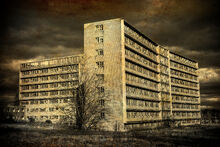
The Army of Revolution's current headquarters
The Army of Revolution’s current headquarters is based in a pre-war mental hospital in the northern fringes of the Detroit Wasteland. While decayed, the buildings are still largely intact, and have been converted for the army’s purposes. The Army have cordoned off much of the grounds, which are now dotted with shacks and other makeshift structures to house their personnel. Other sections of the grounds remain open and are used for training and exercise.
In addition, the army maintains a number of outposts across its territory. These facilities are usually built into pre-war structures that have been fortified and are in at least passible condition. These outposts are used as forward operational bases for the staging of patrols and other such operations, as well as keeping an eye on the army’s enemies.
Finally, despite their losses in the Revolutionary War, the army was still able to hold two of the settlements that they occupied during the early stages of the campaign. While they have been fortified against any attempts to recapture them, they have been allowed to operate with a modicum of normality. However, the Army does skim a share off to top of all business activities, and confiscates any weapons or technology that it feels would be useful to them.
Allies
The Foundry
While not actually located within the Detroit Wasteland, the Foundry has become a key ally to the Army of Revolution. With its capacity to mass-produce weapons, the industrial city serves as a key supplier to the Army, allowing it to achieve some degree of standardisation among its disparate forces. Following the end of the Flint River War, the Foundry has supplied the Army of Revolution with a constant stream of weapons, which has helped speed up their reconstruction.
On top of all this, the leadership of the Army of Revolution sees the Foundry as being more then just an arms supplier. The two of them do share a human supremacist philosophy, even if the Foundry’s is more opportunistic based on creating an enemy rather then an underlying goal. Ideally, the Army of Revolution’s leadership would like to expand the alliance between the two, and combine forces to build a human nation in Michigan.
Events in early 2287 saw this alliance sour and then collapse. This would lead to the Foundry becoming the Army's enemy, a move that would prove catastrophic.
Cake or Death
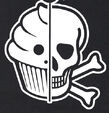
Cake or Death
Lead by Mrs Mothrapickles, the Cake or Death raider band has become a strange ally of the Army of Revolution. During the Revolutionary war, Mrs Mothrapickles was paid off in Fancy Lads Snack Cakes in order to ensure that she would not interfere in their business. This arrangement served her needs well, allowing her to dose up on sugary treats in exchange for doing nothing.
In 2287, the Army would sweeten the deal by offering Mrs Mothrapickles both guns and cakes (fulfilling both halves of the 'cake or death' arrangement) in exchange for her supporting their forces. While she was somewhat concerned about the idea of serving as the Army's mercenaries, the idea of more cake did appeal to her, resulting in an agreement. What the Army of Revolution didn't realise was that Mrs Mothrapickles had her own plans in mind.
Scrap Dogs
Scrap Dogs
The largest raider band in the Detroit Wasteland, the Scrap Dogs were initially an obstacle for the Army of Revolution. During the Revolutionary War, they refused to allow the army safe passage through their territories, seeing the Revolutionaries as being potential targets or even recruits. Not wanting to open up another front or make another enemy, the Army was forced to take a long detour around the Scrap Dogs’ territory, which served to only further stretch their supply lines and slow communications.
Following the Scrap Dogs’ mauling at the hands of the Park Lane Safety Patrol, their members were somewhat more willing to negotiate with the Army. The Revolutionaries agreed to supply them with weapons (That had in turn been bought from the Foundry) and give them a regular supply of raw materials as well as a share of any bounties from future conquest in exchange for not only safe passage but also military assistance. The Scrap Dogs agreed, not willing to turn down a good deal and looking to the long term where they could turn on the Army of Revolution in the future.
Enemies
Black Skull Company
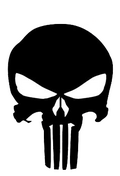
Black Skull Company
The rivalry between the Army of Revolution and Black Skull Company goes back to the formation of both groups. The Black Skulls have always positioned themselves as being in opposition to the Army of Revolution, and in past managed to drive them out of the Detroit Wasteland. During the Revolutionary War, it was the Black Skulls who lead the counterattack against the Army’s advance that ultimately resulted in their defeat.
At present, the Army of Revolution sees Black Skull Company as being the single greatest threat to their future operations. With this in mind, the Army have developed plans to eliminate them as a threat, if not destroy them outright, as a prelude to any future action. However, they also understand that the Black Skulls are well armed, well trained and coordinated, and that any move against them will be costly, regardless of the outcome.
David David David David David David Plop
While on the surface he may seem to be just another deranged, drug-addled raider, the Army of Revolution sees David David David David David David Plop as being a considerable threat. During the Revolutionary War, he managed to inflict considerable damage to their forces. Whether this was by accident or design remains unclear, but his crazed and unpredictable nature makes him a threat to them regardless. Added to this is his use of a Power Armor suit, an asset that the Army does not possess themselves. Ideally, the Revolutionaries want to eliminate David Plop while being able to salvage his suit for their own.
Notable Members
Martin Kruger
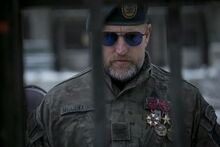
Colonel Kruger
The current leader of the Army of Revolution, Martin Kruger ascended to the position after the Revolutionary War. Faced with the staggering losses the army had suffered, he and a group of other officers confronted then-leader Olivia Milton and essentially forced her to step down. Having inherited a shattered and demoralised unit, Kruger engaged in a program of rebuilding and restructuring, while also taking steps to staunch losses and bring what was left back up to fighting condition.
The son of one of the Army’s founding officers, Kruger genuinely believes in its goals of creating a human state in the Detroit region. He is unashamedly opposed to Ghouls and Super Mutants, and sees them as being a blight on the earth that must be eliminated. His manner is usually blunt and to the point, leaving little room for niceties or small talk. It is only in negotiations with potential allies that he shows any degree of tact or diplomacy. Quietly, he somewhat admires the Forgemaster both for the state that they have built and the degree of blind loyalty they receive from their followers.
Kyle Bleaker
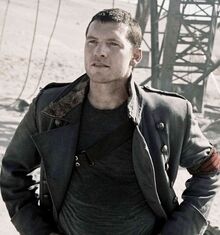
Lt. Bleaker
A lieutenant in the Army, Kyle Bleaker commands one of its forward outposts in the Detroit Wastes. One of those who voluntarily joined its forces, he does not entirely embrace its beliefs. While he does feel that the Detroit Wasteland needs the strong guiding hand and order that the Army would bring, he does not feel that they need to do such at the expense of Ghouls and others who do not fit the army’s ideals of human purity.
Bleaker fought in the Revolutionary War and was one of the few survivors of his unit. He feels that their deaths were as much due to enemy action as they were the poor decisions made by the Army’s leadership. As such, he has become a vocal supporter of Kruger’s reforms to the Army’s structure and operations.
Shelbie Grande
One of Colonel Kruger’s greatest assets, Grande does not appear on any of the army’s rosters, nor is she a part of any given unit. Rather, she is an intelligence agent, given broad discretionary powers to roam the Detroit Wasteland in the name of gathering information for the army’s use. Usually posing as a free trader, she can easily enter settlements and use her position to accomplish her goal. This is aided by her somewhat friendly and outgoing persona, which encourages others to engage with her.
Mister Asakai
Listed in the Army of Revolution’s inventory as an ‘external client relations manager’, Mister Asakai (His first name is known only to a few) serves as a liaison to mercenaries and other freelance agents that are hired by the Army of Revolution. He has no overt connection to the Army, wears no uniform, rarely uses a gun and would be just about completely useless on the battlefield. However, he also has the combination of charisma, quick wits and deep pockets needed to hire a man to do horrible things to his fellow man in the name of earning a few quick caps.
While he often works out of Park Lane, Asakai spends his time rotating between different communities depending on the needs of his current assignment. He has used his skills to ensure that he is well protected and never wants for anything, while still managing to remain largely anonymous.
| This has been written by KayEmm. Please contact this user before editing this article. |
| This has been written by DayteBayte. Please contact this user before editing this article. |
| This has been written by Darthfish. Please contact this user before editing this article. |
